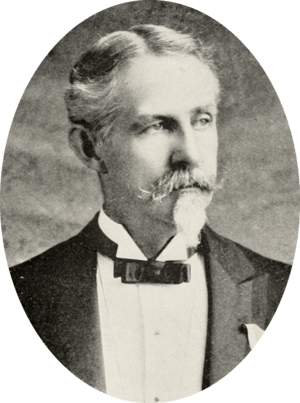Edward H. Ripley facts for kids
Quick facts for kids
Edward Hastings Ripley
|
|
|---|---|

Ripley in 1899
|
|
| Born | November 11, 1839 Rutland, Vermont, US |
| Died | September 14, 1915 (aged 75) Rutland, Vermont, US |
| Place of burial |
Evergreen Cemetery, Rutland, Vermont
|
| Allegiance | United States (Union) |
| Service/ |
Union Army |
| Years of service | 1862–1865 |
| Rank | |
| Commands held |
|
| Battles/wars | American Civil War |
| Other work | Businessperson Banker Horse breeder |
Edward Hastings Ripley (born November 11, 1839 – died September 14, 1915) was a businessman from Vermont. He was also an important officer in the Union Army during the American Civil War. He became a brevet Brigadier General, which is a special honorary rank. He led soldiers in battles and was the first officer to lead troops into Richmond when the war ended.
Contents
Early Life and Education
Edward H. Ripley was born in Rutland, Vermont on November 11, 1839. He went to school in his hometown. Later, he studied at Troy Conference Academy in Poultney, Vermont. From 1858 to 1862, he attended Union College.
Serving in the Civil War
Ripley left college early in 1862 to join the Union Army. He started as a private in the 9th Vermont Infantry regiment. Even though he left early, Union College still gave him his degree.
Rising Through the Ranks
Ripley quickly moved up in rank. He became a sergeant, then a captain. As a captain, he led Company B of his regiment. He fought in the Shenandoah Valley Campaign in 1862. This included the Siege of Suffolk. That summer, he was promoted to major.
In September 1862, Ripley was captured during the Battle of Harpers Ferry. He was released in January 1863. He continued to serve with the 9th Vermont in Virginia and North Carolina. In May 1863, he became a lieutenant colonel. Just a week later, he was promoted to colonel and took command of his regiment.
Leading Brigades
Ripley was later put in charge of a military area in Beaufort and New Bern, North Carolina. In August 1864, he received the special rank of brevet brigadier general. He was then given command of the 1st Brigade, 2nd Division, XVIII Corps. This unit was part of the Army of the James.
He later commanded the 2nd Brigade. He fought in battles like the Battle of Chaffin's Farm. Ripley was wounded twice during his service. He was then assigned to lead the 1st Brigade, 3rd Division, XXIV Corps. This group had an important job: they were the first Union troops to enter Richmond after the Confederate surrender. Their orders were to put out fires, stop looting, and keep order in the city.
Protecting President Lincoln
Ripley was in charge of the military area that included Richmond. He stayed there until the city's local government was back in charge. When President Abraham Lincoln visited Richmond in April 1865, Ripley learned about a plan to harm the President. He met with Lincoln and urged him to be more careful. Lincoln refused, saying it was more important for him to be seen among the people. He believed it showed that the fighting was over. He also felt that if someone truly wanted to harm him, extra security wouldn't stop it.
Ripley left the army in June 1865.
After the War
After the Civil War, Ripley returned to Vermont. He also kept a home in New York City. He worked with his brother William in their family's marble business. They later sold it to the Vermont Marble Company.
Ripley was involved in many businesses. He built the Holland House Hotel in New York City. He also helped build and run the New Jersey’s Raritan River Railroad. He was a founder and director of the United States and Brazil Steamship Line. He was also the President of the Rutland Marble Savings Bank and Vice President of the Rutland County National Bank.
He also had a successful horse breeding farm. Many of his horses were bought for use in South America. The place where his farm used to be is now a restaurant and gift shop. The burial spot of "Old John," the horse Ripley rode for most of the Civil War, is still there.
Public Service and Recognition
Ripley was a member of the Republican Party. He held local offices in Rutland. He also served in the Vermont House of Representatives from 1886 to 1887.
He was active in groups for Civil War veterans, like the Reunion Society of Vermont Officers and the Grand Army of the Republic. He was president of the Reunion Society twice.
Ripley received honorary master's degrees from Norwich University (1910) and Union College (1915).
He also spoke and wrote about his experiences in the Civil War. His speech, The Capture and Occupation of Richmond, April 3, 1865, was printed as a book in 1907. His diary was also published in 1960 as Vermont General, The Unusual War Experiences of Edward Hastings Ripley.
Death and Burial
Edward Ripley passed away in Rutland on September 14, 1915. He is buried in Rutland's Evergreen Cemetery.
Family Life
In 1878, Edward H. Ripley married Amelia Dyckman Van Doren. They had two daughters, Alice and Amelia. Both daughters were married in a double ceremony in 1909.
Edward H. Ripley's father was William Young Ripley, a well-known businessman and banker. Edward's brother, William Y. W. Ripley, was also a Civil War officer and received the Medal of Honor. His half-sister, Julia Caroline Dorr, was a famous poet.

